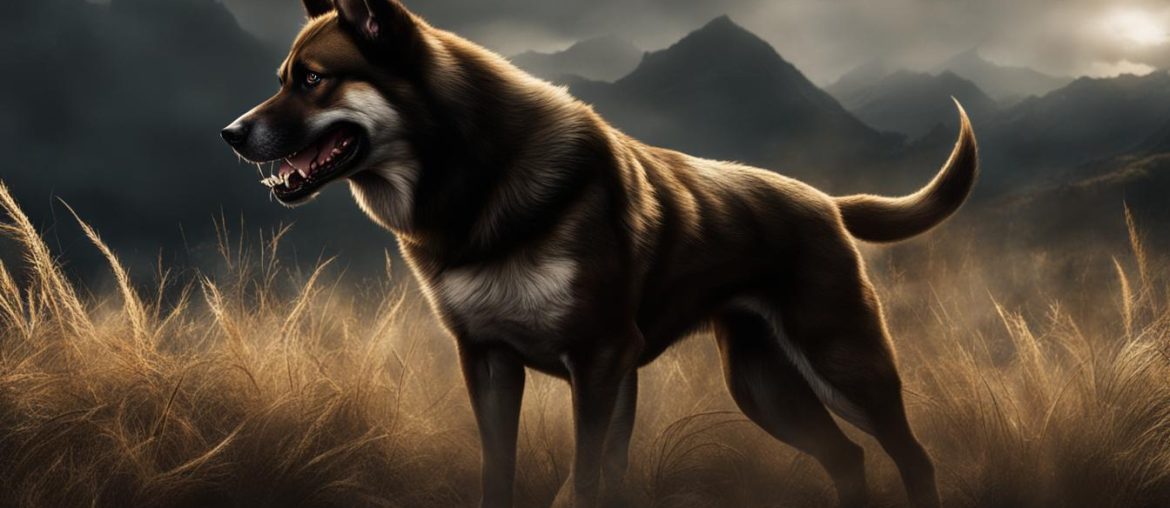In the dark and gripping world of Stephen King’s novel and film, Cujo stands out as a terrifying and unforgettable character. But have you ever wondered what kind of dog Cujo actually was? In this article, I will unravel the dog breed behind Cujo’s menacing presence and delve into the fascinating details surrounding this iconic canine.
Key Takeaways:
- Cujo, the menacing dog in Stephen King’s novel and film, was a Saint Bernard.
- Saint Bernards are typically known for their friendly and docile nature, unlike the aggressive portrayal of Cujo.
- Cujo’s breed description should not be generalized based on the fictional representation in the story.
- The legacy of Cujo serves as a reminder of the power of storytelling and the lasting impact of iconic characters in literature and film.
- Cujo’s portrayal as a terrifying dog with rabies symbolizes the dark side of human nature and the consequences of unchecked aggression.
The Origin and Story of Cujo

Cujo, the eponymous canine in Stephen King’s novel and the subsequent film adaptation, is a central character in a gripping tale of horror and suspense. The story revolves around the beloved family pet of the Cambers, a Saint Bernard named Cujo, whose life takes a tragic turn when he becomes infected with rabies. As the disease takes hold, Cujo’s once gentle and loyal nature is transformed into a terrifying and menacing force.
In the novel, Stephen King provides additional insight into Cujo’s perspective, offering a unique glimpse into the tragic journey of a dog who was once a beloved companion. The terrifying transformation of Cujo serves as a chilling reminder of the unpredictable and destructive potential that lies within every living being, making him a haunting and memorable character in the realm of horror fiction.
The film adaptation of Cujo brought the character to life on the big screen, capturing the terror and suspense of the source material. The movie follows the relentless rampage of a rabid Cujo as he terrorizes the town of Castle Rock, Maine, instilling fear in the hearts of Donna and Tad Trenton. The portrayal of Cujo’s descent into madness and the resulting chaos he inflicts upon the community evokes a sense of primal fear and showcases the power of storytelling to captivate and unsettle audiences.
| Key Points | Details |
|---|---|
| Cujo’s Origin | Stephen King’s novel and subsequent film adaptation |
| The Story | Beloved family pet turned terrifying force due to rabies |
| Cujo’s Perspective | Insight into the tragic transformation from a once gentle companion |
| Film Adaptation | Capturing the terror and suspense of Cujo’s rampage |
“The movie adaptation of Cujo allowed audiences to witness the horrifying transformation of this beloved dog on the big screen, intensifying the impact of Cujo’s story and further solidifying his place in popular culture.” – Stephen King
Cujo’s Breed Description

When it comes to Cujo’s breed, the menacing canine in Stephen King’s novel and film adaptation, he is portrayed as a two-hundred-pound Saint Bernard. However, it is important to note that Saint Bernards are generally known for their friendly and docile nature. Cujo’s aggressive behavior in the story is a fictional portrayal and not representative of the breed as a whole.
As depicted in the novel and film, Cujo’s appearance aligns with the typical physical traits of a Saint Bernard. These dogs are known for their large size, weighing around two hundred pounds. Their gentle temperament and loyalty make them popular as family pets. Despite Cujo’s transformation into a vicious and terrifying character due to rabies, it is crucial to remember that this portrayal does not reflect the breed’s true nature.
Characteristics of Cujo Breed
- Size: Saint Bernards are large dogs, typically weighing around two hundred pounds.
- Temperament: They are known for their friendly and gentle nature, making them excellent companions.
- Appearance: Saint Bernards have a distinctive appearance with a stocky build, broad head, and expressive eyes.
- Strength: Despite their friendly disposition, their size and strength require proper training and handling.
- Intelligence: Saint Bernards are intelligent dogs that require mental stimulation and consistent training.
To summarize, Cujo’s breed description aligns with that of a Saint Bernard, known for their large size, friendly nature, and loyalty. It is essential to separate the fictional portrayal of Cujo from the reality of the breed, as Saint Bernards are generally gentle and loving family pets.
| Characteristic | Description |
|---|---|
| Size | Saint Bernards are large dogs, typically weighing around two hundred pounds. |
| Temperament | They are known for their friendly and gentle nature, making them excellent companions. |
| Appearance | Saint Bernards have a distinctive appearance with a stocky build, broad head, and expressive eyes. |
| Strength | Despite their friendly disposition, their size and strength require proper training and handling. |
| Intelligence | Saint Bernards are intelligent dogs that require mental stimulation and consistent training. |
Cujo’s Representation in the Film
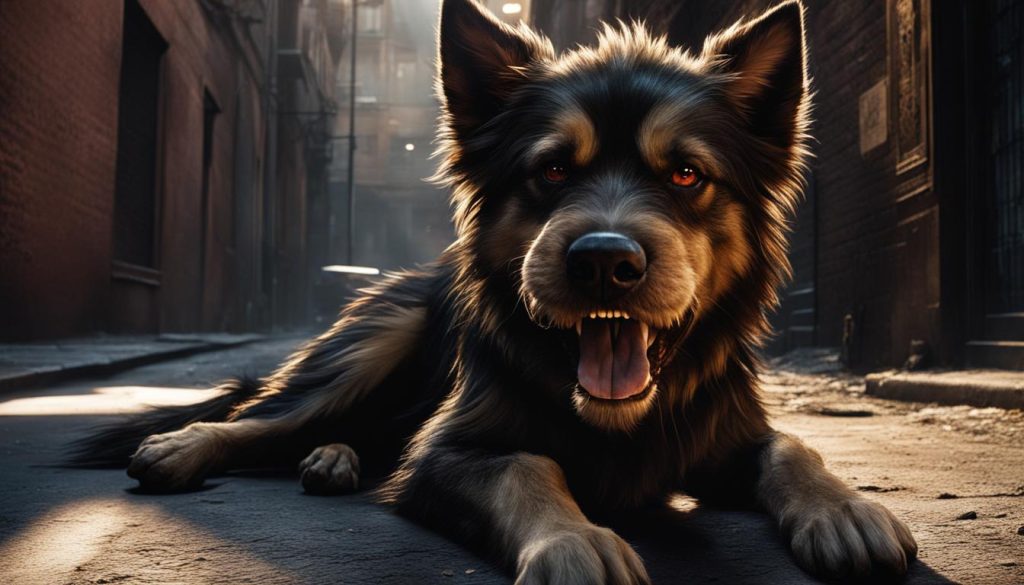
In the film adaptation of Cujo, the character of Cujo was brought to life through a combination of real dogs, mechanical props, and human actors. Several St. Bernards were used to portray Cujo, along with a black Labrador-Great Dane mix dressed in a St. Bernard costume. Additionally, stuntman Gary Morgan wore a large dog costume for certain shots, adding to the realism of Cujo’s menacing presence on screen.
The use of a variety of techniques and actors to portray Cujo allowed for a dynamic and engaging performance. The real dogs brought an authenticity to the character’s movements and physicality, while the mechanical props and human actors added an element of control and precision to create suspenseful and terrifying scenes.
The portrayal of Cujo in the film effectively captured the essence of the character from Stephen King’s novel. Through the combination of practical effects and performances, Cujo became a memorable and iconic figure in the horror genre, further enhancing the impact of the story on audiences.
The film’s portrayal of Cujo
The film’s portrayal of Cujo is a testament to the creativity and skill of the filmmakers, who were able to bring a fictional character to life in a believable and terrifying way. By utilizing a combination of real dogs, mechanical props, and human actors, the film was able to capture the essence of Cujo and create a truly memorable and chilling cinematic experience.
| Real Dogs | Mechanical Props | Human Actors |
|---|---|---|
| Multiple St. Bernards | Costume: Black Labrador-Great Dane mix | Stuntman: Gary Morgan |
| Authentic movements and physicality | Precision and control | Performance and interaction |
Cujo’s Impact and Legacy
One cannot underestimate the impact and lasting legacy of Stephen King’s canine character, Cujo. From the novel to the film adaptation, Cujo has become an iconic figure in popular culture, leaving a lasting impression on audiences worldwide.
Cujo’s cultural significance lies in its ability to tap into primal fears and highlight the potential dangers that may lurk in unexpected places. The transformation of a once gentle and beloved dog into a vicious monster due to rabies struck a chord with readers and viewers alike. It serves as a cautionary tale, reminding us of the destructive potential within individuals and the importance of controlling our emotions.
As one of Stephen King’s most recognizable characters, Cujo has solidified the author’s reputation as a master of horror. The success of the novel and film adaptation further established King’s standing within the literary world. Cujo’s impact on the horror genre continues to resonate today, with discussions of a potential remake and its enduring relevance in exploring psychological horror.
| Cujo’s Impact | Cujo’s Legacy | Cujo’s Cultural Significance |
|---|---|---|
| Cujo has left a lasting impact on popular culture. | Cujo’s legacy showcases the power of storytelling. | Cujo highlights the potential dangers lurking within us all. |
| Cujo is one of Stephen King’s most recognizable characters. | The novel and film adaptation have garnered a significant fan base. | The story serves as a cautionary tale. |
| The success of Cujo solidified King’s reputation as a master of horror. | Cujo’s impact on the horror genre can still be felt today. | Discussions of a potential remake demonstrate its enduring relevance. |
Cujo’s Psychological Symbolism
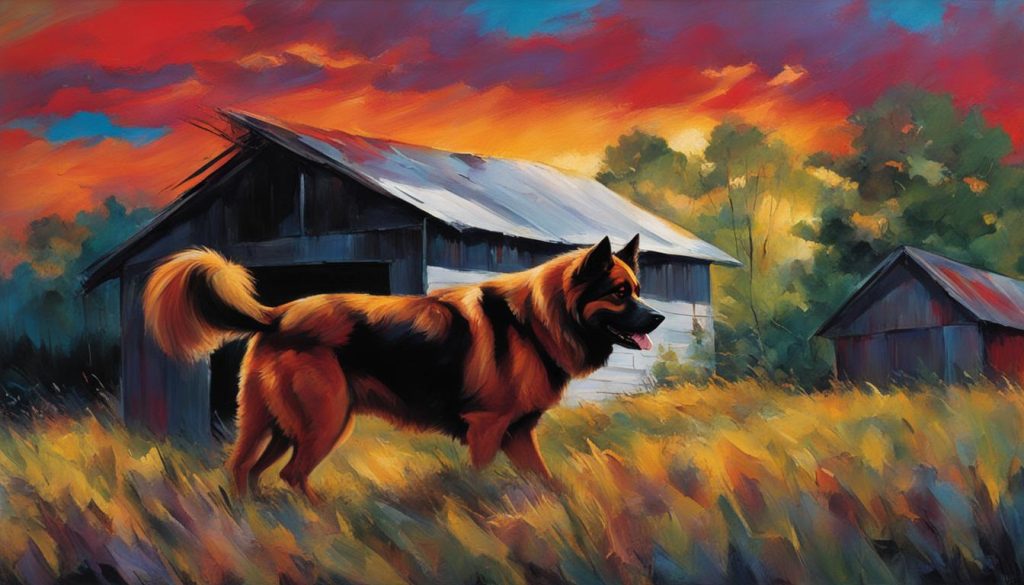
Cujo, as a character, holds significant psychological symbolism within Stephen King’s novel and film adaptation. The transformation of a once-friendly and loyal dog into a vicious monster represents the darker aspects of human nature. Cujo’s journey from docile pet to rabid killer serves as a cautionary tale, highlighting the potential consequences of unchecked anger and aggression.
This psychological symbolism can be interpreted as a reflection of the destructive potential that resides within individuals. Cujo’s descent into madness and violence underscores the importance of understanding and controlling one’s emotions. By exploring the psychological aspects of Cujo, the narrative prompts readers and viewers to consider the impact of their own actions and the potential harm they may cause if they fail to manage their emotions effectively.
“Cujo’s transformation into a terrifying monster is a chilling reminder of the dangers that exist within ourselves when we let anger and aggression take control. It serves as a stark warning to confront and address our own inner demons, lest we become consumed by them.”
The psychological depth of Cujo’s character adds a layer of complexity to the story, elevating it beyond a simple tale of a rabid dog. It invites analysis and introspection, encouraging audiences to contemplate the human condition and the potential for darkness that lurks within us all. By delving into Cujo’s symbolism and meaning, we gain a deeper understanding of the profound impact this character has had on popular culture and the enduring legacy of Stephen King’s work.
The Psychological Transformation of Cujo
| Symbol | Meaning |
|---|---|
| Rabid Dog | Represents uncontrolled anger and aggression |
| Cujo’s Descent into Madness | Symbolizes the loss of innocence and the corrupting influence of disease |
| Violence and Destruction | Reflects the consequences of unchecked emotions and the potential for harm |
Cujo’s Reception and Controversies
When Cujo was released, it quickly garnered attention for its explicit language, violence, and sexual content. This led to controversies surrounding the novel and calls for its removal from libraries and schools. Critics argued that the book’s content was inappropriate for young readers due to its graphic nature and adult themes. Despite the controversy, Cujo’s popularity remained strong, and it continued to resonate with audiences.
In addition to the controversies, Cujo also received mixed reception from critics. While some praised Stephen King’s ability to create suspense and terror, others found fault with the novel’s pacing and character development. The film adaptation faced similar reception, with some praising the performances and the intense portrayal of Cujo, while others criticized its deviation from the source material.
Despite the polarizing opinions, Cujo’s reception among audiences was generally positive. The film achieved moderate success at the box office and developed a cult following over the years. Its intense and disturbing portrayal of a once lovable dog resonated with horror fans and solidified Cujo as a memorable character in Stephen King’s repertoire.
The Influence of Cujo on Stephen King’s Career
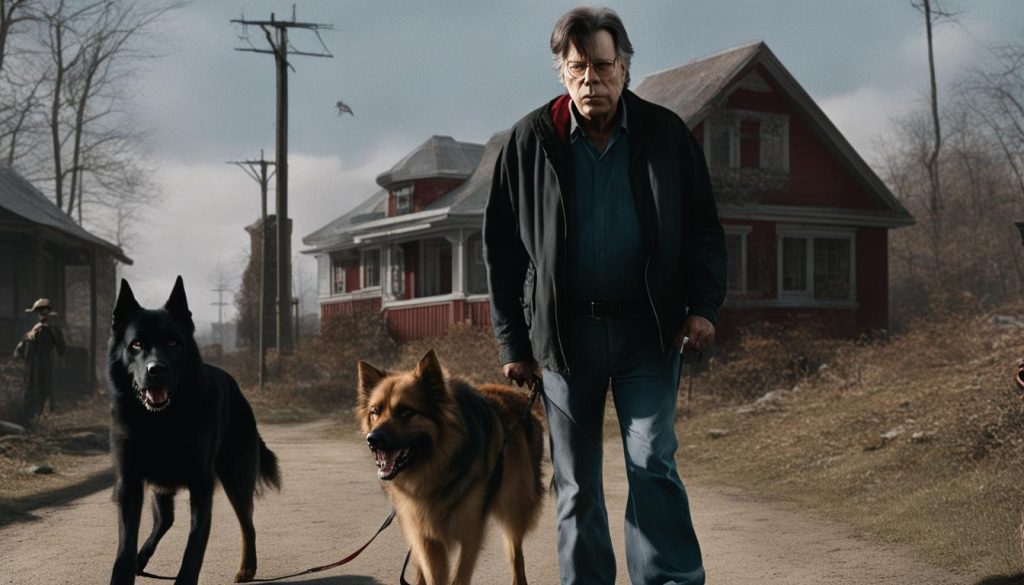
Stephen King’s novel and subsequent film adaptation of Cujo have had a profound impact on his career as a writer. The success of Cujo solidified King’s reputation as a master of horror and further established his standing within the literary world. The terrifying and memorable character of Cujo showcased King’s ability to create complex and captivating stories that resonate with readers.
Cujo’s significance in King’s works extends beyond the novel and film. The character represents the exploration of primal fears and the darker aspects of human nature. Cujo’s transformation from a friendly pet to a rabid monster serves as a cautionary tale, warning readers of the consequences of unchecked anger and aggression. Through Cujo, King delves into the psychological depths of his characters, allowing readers to confront their own fears and examine the complexities of the human psyche.
Furthermore, Cujo’s lasting impact on Stephen King’s career can be seen in his subsequent works. The success and recognition garnered from Cujo propelled King to new heights of popularity and solidified his place as one of the most influential writers in the horror genre. The character of Cujo remains an iconic figure in King’s body of work, serving as a testament to his ability to craft compelling and terrifying narratives.
The Psychological Depths of Cujo
The character of Cujo represents more than just a terrifying monster; it embodies the deeper psychological symbolism present in Stephen King’s works. Cujo’s transformation into a rabid killer serves as a reflection of the darker impulses that lurk within all individuals. King delves into the themes of unchecked anger, suppressed emotions, and the consequences of unresolved conflicts.
Through Cujo’s descent into madness, King explores the complexities of human nature and the potential for violence that exists within us all. Cujo becomes a vessel for these suppressed emotions, serving as a reminder of the importance of self-awareness and emotional control. The character acts as a mirror, forcing readers to confront their own internal struggles and contemplate the potential consequences of allowing their own darkness to consume them.
Impact on the Horror Genre
Cujo’s impact extends beyond Stephen King’s career, leaving an indelible mark on the horror genre as a whole. The novel and film adaptation have become iconic within the genre, influencing future writers and filmmakers. Cujo’s portrayal of a beloved family pet turning into a vicious monster tapped into primal fears and showcased the potential horrors that can lurk in everyday life.
Stephen King’s ability to create unforgettable characters, such as Cujo, has inspired countless writers to delve into the depths of psychological horror. The enduring popularity of Cujo serves as a testament to its lasting impact on the genre, solidifying its place as a classic example of the psychological exploration of fear and the human psyche.
The Evolution of Cujo’s Legacy
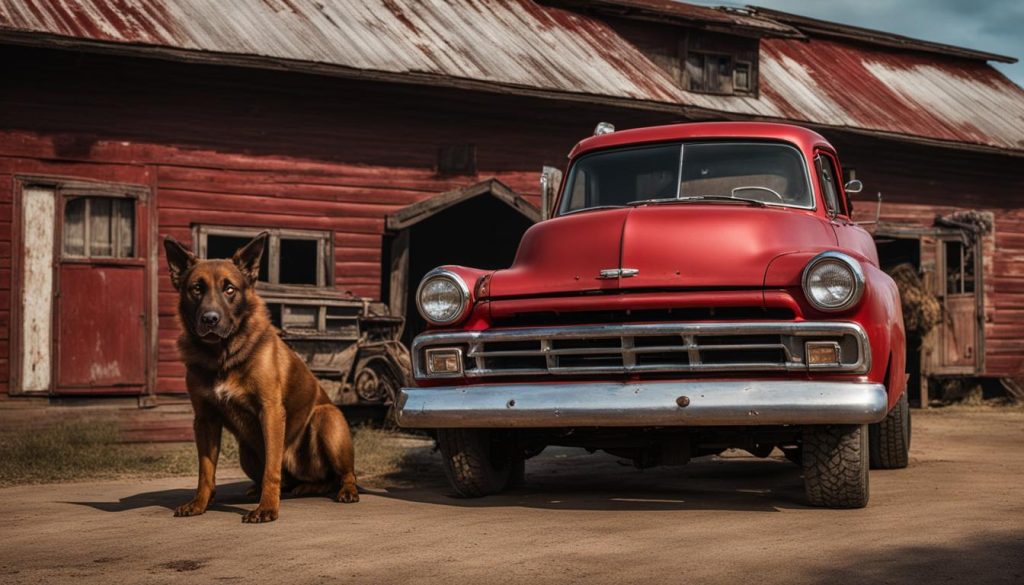
Cujo, the iconic canine character from Stephen King’s novel and film adaptation, has left an indelible mark on the horror genre. Since its release, Cujo has sparked discussions about its potential remake and continues to influence the way horror stories are crafted.
The enduring popularity of Cujo can be attributed to its exploration of primal fears and the psychological aspects of human nature. Through the transformation of a friendly family pet into a vicious monster due to rabies, Cujo serves as a cautionary tale, reminding us of the dangers that can reside within even the most beloved companions.
With its gripping narrative and engaging characters, Cujo has solidified its place as a horror classic. Its impact on the genre can still be felt today, as the story continues to resonate with audiences and inspire new works in the genre. As discussions about a potential remake persist, the evolution of Cujo’s legacy demonstrates the enduring fascination with this terrifying tale.
The Evolution of Cujo’s Legacy
| Year | Development |
|---|---|
| 1981 | Release of the novel Cujo by Stephen King |
| 1983 | Film adaptation of Cujo |
| 1992 | Re-release of Cujo in theaters, garnering renewed interest |
| 2010 | Rumors of a potential Cujo remake begin to circulate |
| 2022 | Possibility of a Cujo remake gains traction, generating excitement among fans |
Wrapping Up
To summarize, Cujo, the legendary canine character from Stephen King’s novel and film adaptation, is a chilling reminder of the potential dangers that can reside within even the most gentle creatures. Through his transformation from a friendly pet to a rabid monster, Cujo serves as a cautionary tale about the consequences of unchecked anger and aggression.
The enduring legacy of Cujo showcases the power of storytelling and the lasting impact of iconic characters in both literature and film. As one of Stephen King’s most recognizable and iconic creations, Cujo has left an indelible mark on popular culture and the horror genre.
With discussions of a potential remake of the film, Cujo’s evolution continues even today. This serves as a testament to the enduring interest and relevance of the story, as well as its continued impact on the exploration of primal fears and psychological horror.
FAQ
What kind of dog was Cujo?
Cujo was a Saint Bernard.
What was the origin and story of Cujo?
Cujo is the eponymous canine character in Stephen King’s novel and film adaptation. The story revolves around a Saint Bernard named Cujo who becomes infected with rabies and terrorizes a small town.
Can you provide a breed description of Cujo?
Cujo is a Saint Bernard, known for its large size and friendly temperament.
How was Cujo represented in the film adaptation?
In the film adaptation, Cujo was portrayed by several St. Bernards, mechanical dogs, and a black Labrador-Great Dane mix in a St. Bernard costume. Stuntman Gary Morgan also wore a large dog costume for certain shots.
What impact and legacy does Cujo have?
Cujo is one of Stephen King’s most recognizable and iconic characters, showcasing the power of storytelling and its ability to evoke fear. The character serves as a cautionary tale and reminder of the potential dangers within individuals.
What psychological symbolism does Cujo possess?
Cujo can be interpreted as a symbol of the destructive potential within individuals, representing the consequences of unchecked anger and aggression.
How was Cujo received and were there any controversies surrounding it?
Cujo faced controversies due to explicit language, violence, and sexual content, leading to calls for its removal from libraries and schools. The film carries an R-rating due to its intensity and unsuitability for young viewers without parental guidance.
What impact did Cujo have on Stephen King’s career?
Cujo solidified Stephen King’s reputation as a master of horror and contributed to the enduring popularity of his works.
How has Cujo’s legacy evolved over time?
Cujo’s legacy continues to evolve, with discussions of a potential remake of the film adaptation. The character’s impact on the horror genre can still be felt today.
Is there a conclusion to this article?
No, this article does not have a conclusion. It is a collection of information and frequently asked questions about Cujo.


